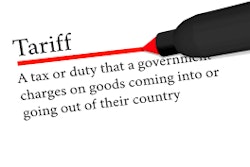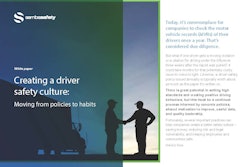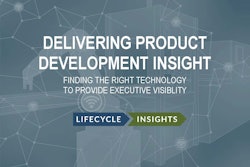
On Jan. 29, 2018, Rand Logistics Inc., one of the largest bulk freight shipping providers in the Great Lakes region, filed for bankruptcy. The CreditRiskMonitor FRISK score had warned of financial stress at the company for more than a year. This meant that there was ample time for their customers to make other plans or switch carriers, and plenty of alternatives because the rest of the water transportation industry has maintained a steady FRISK score over the last year. Other indicators such as free cash flow and debt to equity ratios also signaled trouble on the horizon from Rand Logistics. In fact, the company issued a press release in November 2017 that a Chapter 11 filing was imminent as part of a restructuring support agreement with private equity firm American Industrial Partners (AIP), who acquired Rand on March 1, 2018.
The question is, were Rand Logistics’ customers and suppliers doing enough to mitigate the impact of insolvency risk before the company declared bankruptcy?
Today’s levels of corporate debt represent an unprecedented risk. And while instruction on how to manage this risk can be dry, its implications are anything but. Global debt conditions have been disconcerting for a while now, and the trend has not changed for the better. The economy looks pretty good right now on the surface, but the current expansion is being driven by ever-increasing levels of debt: government debt, consumer debt and business debt. The longer the current situation persists, the more risk will build up in the economy, raising the stakes for anyone tasked with being prepared to respond.
Risk management is part of every supply chain manager’s planning process, but that doesn’t always mean preventing the risks themselves—it means watching carefully for their presence in the supply base and being prepared to act. Luckily, there are several common signals companies can look for to monitor insolvency risk in the supply chain, including bond ratings, stock price and financial ratios.
Bond Credit Rating
The easiest, fastest insolvency risk signal is a company’s corporate family bond rating, or “issuer rating,” or alternatively a senior unsecured bond rating—if there is one.
When you’re talking about a public company or a large private company, look for a bond rating. If a company is investment-grade (at least a Baa rating by Moody’s Investors Services or BBB rating by Standard & Poors or Fitch Group, the three largest credit rating agencies) you can be fairly sure the company has a low risk of failure. See investment grade, and except for the largest exposures, you are done.
But it can be okay to work with non-investment-grade (also called high yield or junk debt) companies. That’s a good thing, because junk debt companies now out-number those with investment grade ratings. As it turns out, higher-rated firms in this category (Ba by Moody’s or BB by S&P or Fitch) are not that bad in the current economic environment. They may be “junk,” but they are good junk. Until we hit a really rough economic patch, like we did in 2008 and 2009, you are unlikely to have trouble from these higher rated so-called junk companies. (Unfortunately, that may come sooner than you think.)
You can sleep easily at night if your suppliers are investment-grade, but below BB you really need to pay attention and have a mitigation plan in place. There is a huge difference in bankruptcy risk between a BB rated company and a B rated company. B is risky, without a doubt, and there are a lot of B rated firms. More rare, and even worse, are Caa/CCC or Ca/CC rated companies. They’re extremely risky; 30 percent are likely to fail within a year or two. Deciding to select one of these companies as a supplier—especially for a product or service that could be disruptive to your ability to generate revenue—is a gamble. So, if you see these lower “junk” ratings, or if no rating is available, you’ll need to do more analysis.
Market Capitalization & Stock Price
The next easy signal to look for—at least for publicly-listed companies—is their market capitalization. If you see a long-term trend of rising market value, the company is unlikely to be in trouble, especially if that rise is steady rather than volatile. Volatility generally means that buyers and sellers of a company’s stock significantly disagree with each other about its investment potential. It is also often associated with higher levels of debt, which leaves the company less financial flexibility. These differences of opinion and diminished flexibility results in a stock price that moves a lot over a relatively short period of time—and that’s not a good thing. It’s especially not great if the stock price is going down. That may sound obvious, but it turns out this is an asymmetric signal. If the stock price falls by 25 percent over a period of a few months, that is a red flag. If it goes up by 25 percent over the same period, that’s not a correspondingly positive signal. A rising stock obviously isn’t bad news, but it is nowhere near as strong a signal as we have when the stock is crashing. We also like to see the market value substantially above the value of total liabilities. At a ratio below 1-to-1 (market value to liabilities), you have a worrisome signal. And if the ratio reaches a small fraction, the company is in real trouble, with an elevated probability that they’ll go bankrupt.
Financial Ratios
If there’s no traded stock, or if the indicators above are worrying, the third set of signals to look for includes financial ratios from the company’s profit and loss statement (P&L) and balance sheet, including:
- Earnings before interest and taxes (EBIT) over total assets,
- Equity over total liabilities,
- Working capital over total assets, and
- Retained earnings over total assets.
Values near zero and negative values in these ratios are serious negative signals. Also, look for trends in the components of these ratios. Free cash flow takes into account capital expenditures and depreciation, and trends in equity, working capital and retained earnings may track similar things, but looking at the array of them provides a fuller picture of the company’s financial performance and therefore their risk of failure. For example, Rand Logistics reported negative cash flow in three of the five quarters before they declared bankruptcy.
Other signals include the interest coverage ratio, or how well the company can cover their interest payments with their profits. A ratio of six and above is good; once a company is down around one or two they can barely make their interest payments, and this is a bad thing, especially if they are highly indebted. Examine both the income statement and the balance sheet. A company with a strong balance sheet typically has the ability to withstand an extended period of poor earnings results—and maybe even negative cash flows. A company with a weak balance sheet might not. That said, a company with a weak balance sheet and a really strong P&L is not likely to be in trouble. There’s no reason to go bankrupt if there is a lot of cash coming in. The company will be able to pay their bills and go about their business even if they owe more than they own. As long as the company has strong cash flow, they are likely to continue operating.
Crowdsourcing: An Innovative New Signal
Credit risk professionals have been sharing their opinions in “credit groups” and in more informal settings for many decades. The next best thing to do when you suspect trouble is to get on the phone and talk to people, including the supplier in question. If you’re doing business with a supplier and the relationship is big enough to matter to your company, chances are it’s big enough to matter to them as well. And don’t forget to use your own company’s credit department as a resource.
The Future of Risk Management
The good news is that in today's economy, four out of five companies are in relatively good shape. The challenge is finding the one in five that’s not in good shape as quickly as possible. If you are tracking more than a few dozen companies, this requires the efficiency and constant monitoring of automation in order to be feasible, and should combine structured data sets (such as financial statements) as well as less structured data such as news and the crowdsourced evidence of which companies credit risk managers are spending their time watching.
The current economic client won’t last forever, so you also need to think about recession-proofing your supply chain. The same monitoring is a great first step.
In addition, there have been major breakthroughs in the application of artificial intelligence (AI) throughout the supply chain, and credit risk monitoring is no exception. Deep neural networks is a type of AI that allows a computer to learn for itself what it should be looking at and to what degree. CreditRiskMonitor just launched its first neural network-driven score—the PAYCE Score, aimed at evaluating companies where financial statements are not available. These are typically private companies that defy evaluation using the typical methods and signals described in this article, because most of those signals are unavailable.
For smaller private companies, it is well known that looking at whether the company pays its bills on time can be a signal of financial strength or stress. The PAYCE score uses AI to examine this data, and achieves a more accurate measure of a company’s financial stress.
Information is the key to monitoring insolvency risk in the supply chain, and the earlier you identify a worrisome risk signal the more time you have to respond through a greater range of alternative responses. They key is to combine prioritization and automation to focus your attention and efforts on the highest risk companies. This effectively allows supply chain managers to turn back the clock and watch for signals of bankruptcy before it happens rather than responding to official news of bankruptcy filings.




















